Top 10 Chinese Cultural Symbols(十大中国文化符号)
- 格式:doc
- 大小:200.50 KB
- 文档页数:6
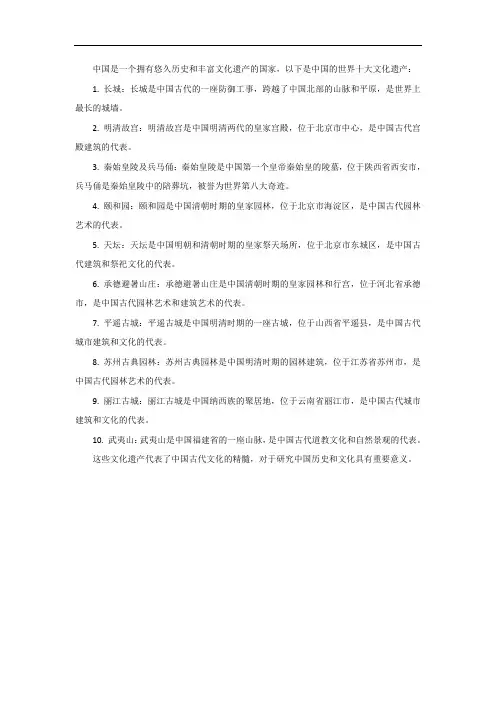
中国是一个拥有悠久历史和丰富文化遗产的国家,以下是中国的世界十大文化遗产:
1. 长城:长城是中国古代的一座防御工事,跨越了中国北部的山脉和平原,是世界上最长的城墙。
2. 明清故宫:明清故宫是中国明清两代的皇家宫殿,位于北京市中心,是中国古代宫殿建筑的代表。
3. 秦始皇陵及兵马俑:秦始皇陵是中国第一个皇帝秦始皇的陵墓,位于陕西省西安市,兵马俑是秦始皇陵中的陪葬坑,被誉为世界第八大奇迹。
4. 颐和园:颐和园是中国清朝时期的皇家园林,位于北京市海淀区,是中国古代园林艺术的代表。
5. 天坛:天坛是中国明朝和清朝时期的皇家祭天场所,位于北京市东城区,是中国古代建筑和祭祀文化的代表。
6. 承德避暑山庄:承德避暑山庄是中国清朝时期的皇家园林和行宫,位于河北省承德市,是中国古代园林艺术和建筑艺术的代表。
7. 平遥古城:平遥古城是中国明清时期的一座古城,位于山西省平遥县,是中国古代城市建筑和文化的代表。
8. 苏州古典园林:苏州古典园林是中国明清时期的园林建筑,位于江苏省苏州市,是中国古代园林艺术的代表。
9. 丽江古城:丽江古城是中国纳西族的聚居地,位于云南省丽江市,是中国古代城市建筑和文化的代表。
10. 武夷山:武夷山是中国福建省的一座山脉,是中国古代道教文化和自然景观的代表。
这些文化遗产代表了中国古代文化的精髓,对于研究中国历史和文化具有重要意义。
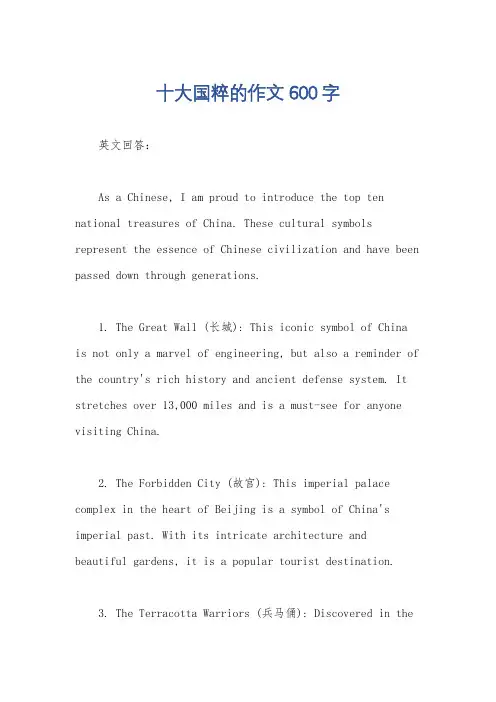
十大国粹的作文600字英文回答:As a Chinese, I am proud to introduce the top ten national treasures of China. These cultural symbols represent the essence of Chinese civilization and have been passed down through generations.1. The Great Wall (长城): This iconic symbol of China is not only a marvel of engineering, but also a reminder of the country's rich history and ancient defense system. It stretches over 13,000 miles and is a must-see for anyone visiting China.2. The Forbidden City (故宫): This imperial palace complex in the heart of Beijing is a symbol of China's imperial past. With its intricate architecture andbeautiful gardens, it is a popular tourist destination.3. The Terracotta Warriors (兵马俑): Discovered in thetomb of Emperor Qin Shi Huang, these life-sized clay soldiers are a testament to China's ancient military prowess. Each warrior is unique and represents a different rank in the army.4. The Peking Opera (京剧): This traditional Chineseart form combines music, dance, and acrobatics to tell stories from Chinese history and mythology. The elaborate costumes and makeup make it a visually stunning experience.5. Chinese Calligraphy (书法): Known as the "art of writing," Chinese calligraphy is a highly respected form of artistic expression. Each stroke is carefully crafted to convey meaning and emotion.6. Chinese Tea (中国茶): With a history dating back thousands of years, Chinese tea is an integral part of Chinese culture. From delicate green tea to robust black tea, there is a type of tea for every occasion.7. Chinese Cuisine (中国菜): Chinese food is renowned for its diverse flavors and regional specialties. Fromspicy Sichuan cuisine to delicate Cantonese dim sum, there is something for every palate.8. Chinese Traditional Medicine (中医): Based on the principles of balance and harmony, traditional Chinese medicine has been practiced for thousands of years. Acupuncture, herbal remedies, and tai chi are just a few examples of this ancient healing art.9. Chinese Silk (中国丝绸): Silk production has been a cornerstone of Chinese culture for centuries. The luxurious fabric is known for its softness and sheen, making it highly prized around the world.10. Chinese Festivals (中国节日): From the colorful lantern festival to the lively dragon boat festival, Chinese festivals are a vibrant celebration of tradition and culture. These festive occasions bring people together to honor the past and look towards the future.中文回答:作为一个中国人,我很自豪地介绍中国的十大国粹。
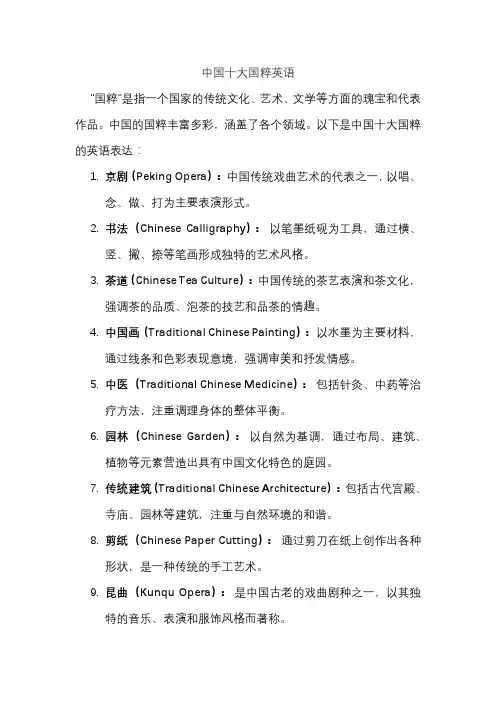
中国十大国粹英语"国粹"是指一个国家的传统文化、艺术、文学等方面的瑰宝和代表作品。
中国的国粹丰富多彩,涵盖了各个领域。
以下是中国十大国粹的英语表达:1.京剧(Peking Opera):中国传统戏曲艺术的代表之一,以唱、念、做、打为主要表演形式。
2.书法(Chinese Calligraphy):以笔墨纸砚为工具,通过横、竖、撇、捺等笔画形成独特的艺术风格。
3.茶道(Chinese Tea Culture):中国传统的茶艺表演和茶文化,强调茶的品质、泡茶的技艺和品茶的情趣。
4.中国画(Traditional Chinese Painting):以水墨为主要材料,通过线条和色彩表现意境,强调审美和抒发情感。
5.中医(Traditional Chinese Medicine):包括针灸、中药等治疗方法,注重调理身体的整体平衡。
6.园林(Chinese Garden):以自然为基调,通过布局、建筑、植物等元素营造出具有中国文化特色的庭园。
7.传统建筑(Traditional Chinese Architecture):包括古代宫殿、寺庙、园林等建筑,注重与自然环境的和谐。
8.剪纸(Chinese Paper Cutting):通过剪刀在纸上创作出各种形状,是一种传统的手工艺术。
9.昆曲(Kunqu Opera):是中国古老的戏曲剧种之一,以其独特的音乐、表演和服饰风格而著称。
10.传统服饰(Traditional Chinese Clothing):如汉服、旗袍等,代表了中国古代的服饰文化。
这些都是中国传统文化的瑰宝,代表了中国千百年来的历史和文化积淀。
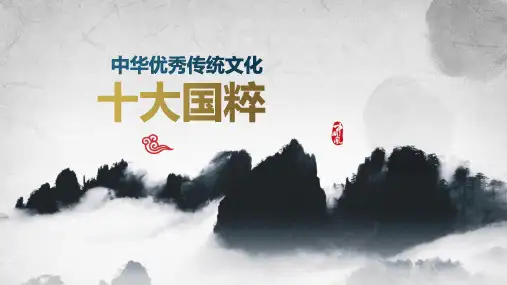
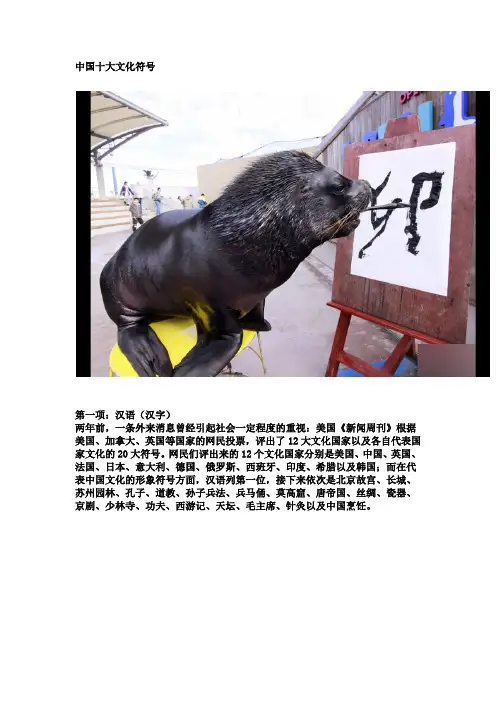
中国十大文化符号第一项:汉语(汉字)两年前,一条外来消息曾经引起社会一定程度的重视:美国《新闻周刊》根据美国、加拿大、英国等国家的网民投票,评出了12大文化国家以及各自代表国家文化的20大符号。
网民们评出来的12个文化国家分别是美国、中国、英国、法国、日本、意大利、德国、俄罗斯、西班牙、印度、希腊以及韩国;而在代表中国文化的形象符号方面,汉语列第一位,接下来依次是北京故宫、长城、苏州园林、孔子、道教、孙子兵法、兵马俑、莫高窟、唐帝国、丝绸、瓷器、京剧、少林寺、功夫、西游记、天坛、毛主席、针灸以及中国烹饪。
第二项:孔子北京师范大学艺术与传媒学院院长王一川教授王一川教授介绍,这个“新闻”引起了他的怀疑,当时他觉得这个结果很奇怪,亦不足信。
因为其中很多所谓文化符号并不符合中国学者对当前中国文化软实力的理性判断。
为此,他委托学生给美国《新闻周刊》发了一封信,得到的回复是美国《新闻周刊》没有做过这样一个网络调查。
第三项:书法为了对这个问题有令人信服的了解和及时应对,他们决定对全国在校大学生做一次抽样调查。
2009年下半年,国家社科基金重大项目“我国文化软实力发展战略研究”课题组,开始按照多阶段整群抽样的方法进行系统调研。
此课题由王一川教授主持,并和董晓萍教授共同担任课题组首席专家,主要参加者有张洪忠副教授和研究生林玮,还有近百名研究人员参与。
课题组在全国18个省、市、自治区的24所高校中发放了近2000份问卷。
调查内容包括三方面,即“全国大学生眼中最具代表性的中外文化符号”、“全国大学生眼中最具推广价值的中国文化符号”与“全国大学生眼中最具推广价值的外国文化符号”。
第四项:长城此次调查就整体排名情况看,当代文化符号普遍落后于传统文化符号,如当代人物符号中的刘晓庆、韩寒、崔健、李泽厚、宋祖英、周杰伦、邓丽君等得分都在200名以后。
科学家和当代新科技符号,如袁隆平、陈景润、联想、百度等的得分均在中间线左右;文学形象符号,如孙悟空、林黛玉、阿Q、许三多等得分也都在200名之后。
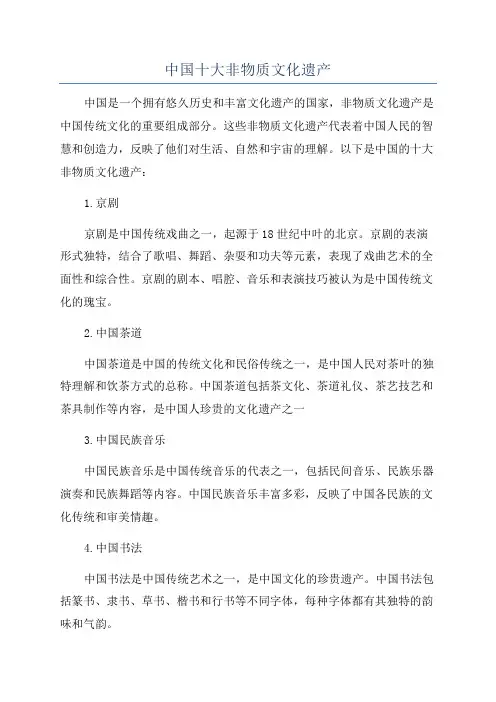
中国十大非物质文化遗产中国是一个拥有悠久历史和丰富文化遗产的国家,非物质文化遗产是中国传统文化的重要组成部分。
这些非物质文化遗产代表着中国人民的智慧和创造力,反映了他们对生活、自然和宇宙的理解。
以下是中国的十大非物质文化遗产:1.京剧京剧是中国传统戏曲之一,起源于18世纪中叶的北京。
京剧的表演形式独特,结合了歌唱、舞蹈、杂耍和功夫等元素,表现了戏曲艺术的全面性和综合性。
京剧的剧本、唱腔、音乐和表演技巧被认为是中国传统文化的瑰宝。
2.中国茶道中国茶道是中国的传统文化和民俗传统之一,是中国人民对茶叶的独特理解和饮茶方式的总称。
中国茶道包括茶文化、茶道礼仪、茶艺技艺和茶具制作等内容,是中国人珍贵的文化遗产之一3.中国民族音乐中国民族音乐是中国传统音乐的代表之一,包括民间音乐、民族乐器演奏和民族舞蹈等内容。
中国民族音乐丰富多彩,反映了中国各民族的文化传统和审美情趣。
4.中国书法中国书法是中国传统艺术之一,是中国文化的珍贵遗产。
中国书法包括篆书、隶书、草书、楷书和行书等不同字体,每种字体都有其独特的韵味和气韵。
5.中国园林艺术中国园林艺术是中国传统艺术之一,反映了中国人对大自然的独特理解和审美追求。
中国园林以山、水、建筑和植物等元素为主要表现方式,具有独特的风格和气质。
6.中国面塑中国面塑是中国传统手工艺之一,是中国人民对形体、颜色和造型的独特理解和表现方式。
中国面塑包括泥塑、糖画、团子等不同形式,被认为是中国传统民间艺术的精品。
7.中国刺绣中国刺绣是中国传统手工艺之一,是中国人民对线条、色彩和纹样的独特理解和表现方式。
中国刺绣包括金线刺绣、绣花、绣片、扎绣等不同形式,具有独特的审美和装饰效果。
8.中国豫剧中国豫剧是中国传统戏曲之一,起源于河南省的豫剧。
中国豫剧的表演形式简洁、生动,具有独特的地方色彩和文化内涵,被誉为中国豫剧艺术的代表之一9.中国民俗节日中国民俗节日是中国传统文化的组成部分,反映了中国人对节气和传统习俗的重视。
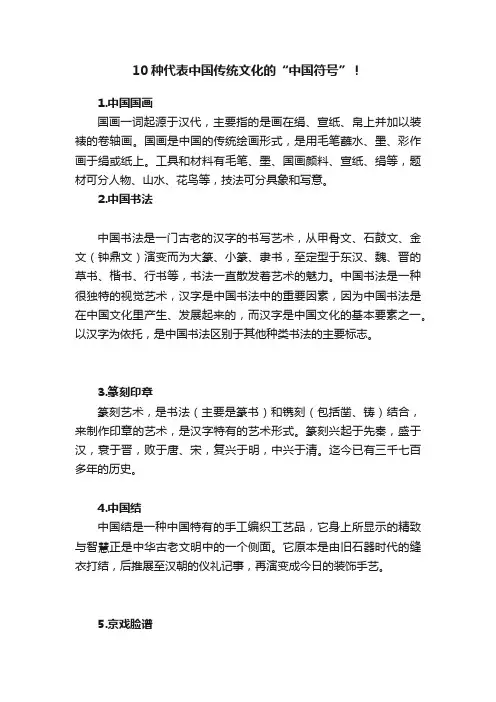
10种代表中国传统文化的“中国符号”!1.中国国画国画一词起源于汉代,主要指的是画在绢、宣纸、帛上并加以装裱的卷轴画。
国画是中国的传统绘画形式,是用毛笔蘸水、墨、彩作画于绢或纸上。
工具和材料有毛笔、墨、国画颜料、宣纸、绢等,题材可分人物、山水、花鸟等,技法可分具象和写意。
2.中国书法中国书法是一门古老的汉字的书写艺术,从甲骨文、石鼓文、金文(钟鼎文)演变而为大篆、小篆、隶书,至定型于东汉、魏、晋的草书、楷书、行书等,书法一直散发着艺术的魅力。
中国书法是一种很独特的视觉艺术,汉字是中国书法中的重要因素,因为中国书法是在中国文化里产生、发展起来的,而汉字是中国文化的基本要素之一。
以汉字为依托,是中国书法区别于其他种类书法的主要标志。
3.篆刻印章篆刻艺术,是书法(主要是篆书)和镌刻(包括凿、铸)结合,来制作印章的艺术,是汉字特有的艺术形式。
篆刻兴起于先秦,盛于汉,衰于晋,败于唐、宋,复兴于明,中兴于清。
迄今已有三千七百多年的历史。
4.中国结中国结是一种中国特有的手工编织工艺品,它身上所显示的精致与智慧正是中华古老文明中的一个侧面。
它原本是由旧石器时代的缝衣打结,后推展至汉朝的仪礼记事,再演变成今日的装饰手艺。
5.京戏脸谱中国京剧脸谱艺术是广大戏曲爱好者的非常喜爱的艺术门类,在国内外流行的范围相当广泛,已经被大家公认为是中华民族传统文化的标识。
6.皮影皮影戏是中国民间古老的传统艺术,老北京人都叫它“驴皮影”。
据史书记载,皮影戏始于西汉,兴于唐朝,盛于清代,元代时期传至西亚和欧洲,可谓历史悠久,源远流长7.武术武术是古代军事战争一种传承的技术。
习武可以强身健体,亦可以防御敌人进攻。
习武之人以“制止侵袭”为技术导向、引领修习者进入认识人与自然、社会客观规律的传统教化(武化)方式,是人类物质文明的导向和保障,是当代传统武学艺术的一种展示。
8.秦砖汉瓦所谓“秦砖汉瓦”是说明这一时期建筑装饰的辉煌,汉代瓦当是以动物装饰最为优秀,除了造型完美的青龙、白虎、朱雀、玄武四神以外,兔、鹿、牛、马也是品种繁多;秦代瓦当以莲纹、葵纹、云纹最多;秦宫遗址出土的巨型瓦当饰以动物变形图案,与铜器、玉器风格十分相近。
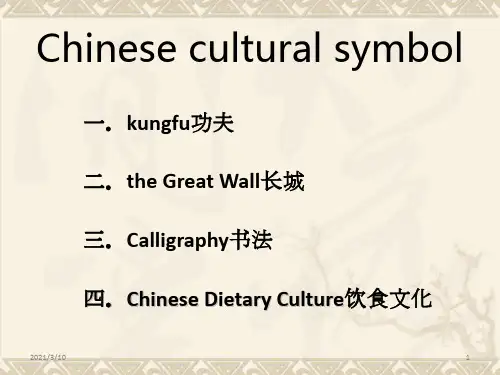
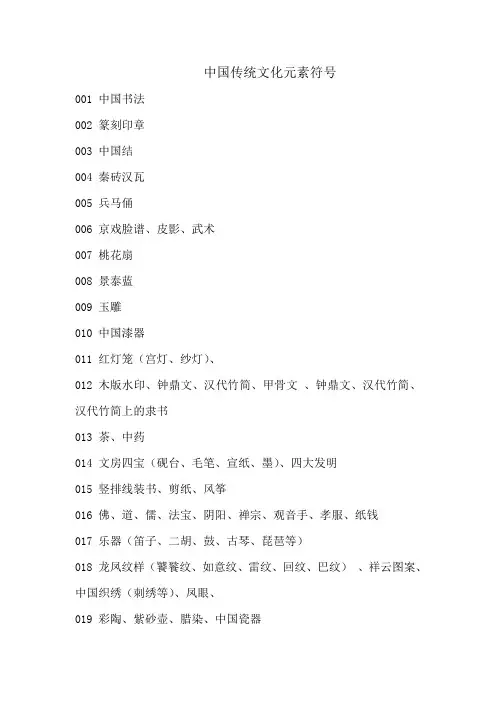
中国传统文化元素符号001 中国书法002 篆刻印章003 中国结004 秦砖汉瓦005 兵马俑006 京戏脸谱、皮影、武术007 桃花扇008 景泰蓝009 玉雕010 中国漆器011 红灯笼(宫灯、纱灯)、012 木版水印、钟鼎文、汉代竹简、甲骨文、钟鼎文、汉代竹简、汉代竹简上的隶书013 茶、中药014 文房四宝(砚台、毛笔、宣纸、墨)、四大发明015 竖排线装书、剪纸、风筝016 佛、道、儒、法宝、阴阳、禅宗、观音手、孝服、纸钱017 乐器(笛子、二胡、鼓、古琴、琵琶等)018 龙凤纹样(饕餮纹、如意纹、雷纹、回纹、巴纹)、祥云图案、中国织绣(刺绣等)、凤眼、019 彩陶、紫砂壶、腊染、中国瓷器020 古代兵器(盔甲、剑等)、青铜器(鼎)021 国画、敦煌壁画、山清水秀、写意画、太极图022 石狮023 飞天、太级024 对联、门神、年画、鞭炮、谜语、饺子、舞狮、中秋月饼025 鸟笼、盆景、五针松、毛竹、牡丹、梅花、莲花026 大熊猫、鲤鱼027 芭蕉扇028 风箱029 黑头发黄皮肤、丹凤眼030 红旗、天安门、五角星、红领巾、红太阳、长江、黄河031 唐装、绣花鞋、老虎头鞋、旗袍、肚兜、斗笠、帝王的皇冠、皇后的凤冠032 泥人面塑、锄头033 清朝大辫子、铜镜、大花轿、水烟袋、鼻烟壶034 华表、牌坊、长城035 园林、寺院、古钟、古塔、庙宇、亭、井、黄土、民宅036 筷子037 数字8,4038 唐诗、宋词、三十六计、孙子兵法、西游记、红楼梦、三国演义、水浒传、诗经039 汉字040 金元宝、如意041 烛台、罗盘、八卦、司南042 棋子与棋盘、象棋、围棋042 黄包车、鼻烟壶、鸟笼、长命锁、糖葫芦043 玉佩、鹫、千层底、刺绣、丝绸、檐044 饼、油条、豆浆、小笼、茶、中药045 毛泽东、人民币、古钱。
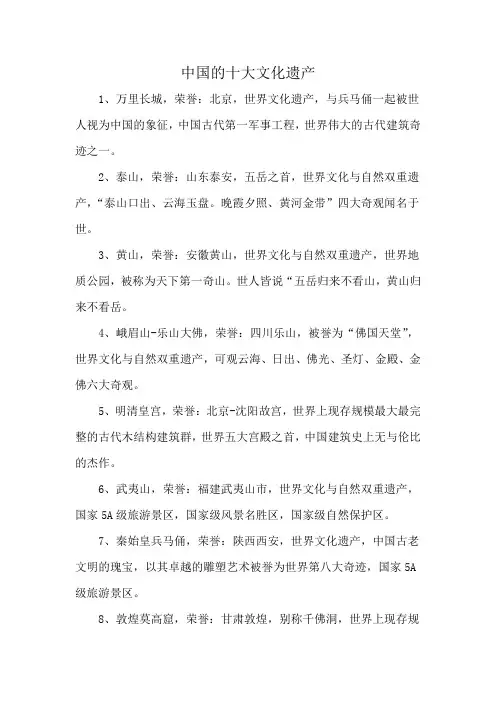
中国的十大文化遗产
1、万里长城,荣誉:北京,世界文化遗产,与兵马俑一起被世人视为中国的象征,中国古代第一军事工程,世界伟大的古代建筑奇迹之一。
2、泰山,荣誉:山东泰安,五岳之首,世界文化与自然双重遗产,“泰山口出、云海玉盘。
晚霞夕照、黄河金带”四大奇观闻名于世。
3、黄山,荣誉:安徽黄山,世界文化与自然双重遗产,世界地质公园,被称为天下第一奇山。
世人皆说“五岳归来不看山,黄山归来不看岳。
4、峨眉山-乐山大佛,荣誉:四川乐山,被誉为“佛国天堂”,世界文化与自然双重遗产,可观云海、日出、佛光、圣灯、金殿、金佛六大奇观。
5、明清皇宫,荣誉:北京-沈阳故宫,世界上现存规模最大最完整的古代木结构建筑群,世界五大宫殿之首,中国建筑史上无与伦比的杰作。
6、武夷山,荣誉:福建武夷山市,世界文化与自然双重遗产,国家5A级旅游景区,国家级风景名胜区,国家级自然保护区。
7、秦始皇兵马俑,荣誉:陕西西安,世界文化遗产,中国古老文明的瑰宝,以其卓越的雕塑艺术被誉为世界第八大奇迹,国家5A 级旅游景区。
8、敦煌莫高窟,荣誉:甘肃敦煌,别称千佛洞,世界上现存规
模最大、内容最丰富的佛教艺术地,世界文化遗产,以精美的壁画和塑像闻名于世。
9、布达拉宫,荣誉:西藏拉萨,世界屋脊的明珠,世界文化遗产,建筑艺术与佛教艺术的博物馆,世界上海拔最高、规模最大的宫堡式建筑群。
10、丽江古城,荣誉:云南丽江,登高揽胜/临河就水/走街入院/入市过桥的古城特色,纳西民族风情,中国最具鲜明特色的民居建筑群。
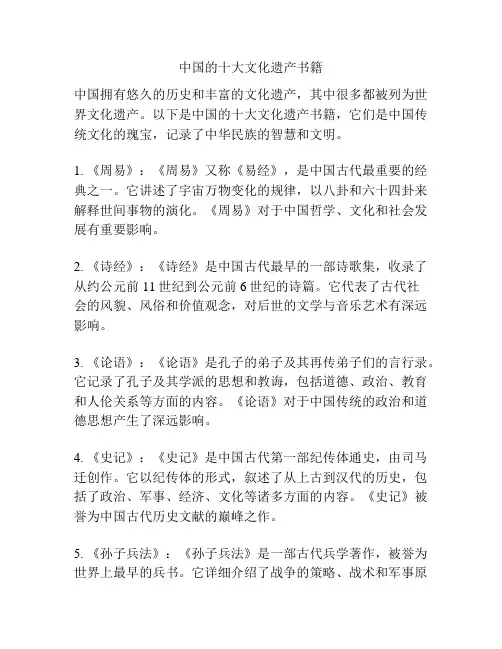
中国的十大文化遗产书籍中国拥有悠久的历史和丰富的文化遗产,其中很多都被列为世界文化遗产。
以下是中国的十大文化遗产书籍,它们是中国传统文化的瑰宝,记录了中华民族的智慧和文明。
1. 《周易》:《周易》又称《易经》,是中国古代最重要的经典之一。
它讲述了宇宙万物变化的规律,以八卦和六十四卦来解释世间事物的演化。
《周易》对于中国哲学、文化和社会发展有重要影响。
2. 《诗经》:《诗经》是中国古代最早的一部诗歌集,收录了从约公元前11世纪到公元前6世纪的诗篇。
它代表了古代社会的风貌、风俗和价值观念,对后世的文学与音乐艺术有深远影响。
3. 《论语》:《论语》是孔子的弟子及其再传弟子们的言行录。
它记录了孔子及其学派的思想和教诲,包括道德、政治、教育和人伦关系等方面的内容。
《论语》对于中国传统的政治和道德思想产生了深远影响。
4. 《史记》:《史记》是中国古代第一部纪传体通史,由司马迁创作。
它以纪传体的形式,叙述了从上古到汉代的历史,包括了政治、军事、经济、文化等诸多方面的内容。
《史记》被誉为中国古代历史文献的巅峰之作。
5. 《孙子兵法》:《孙子兵法》是一部古代兵学著作,被誉为世界上最早的兵书。
它详细介绍了战争的策略、战术和军事原则,并强调了兵器运用和智谋的重要性。
《孙子兵法》对于世界军事思想发展产生了深远影响。
6. 《离骚》:《离骚》是中国古代伟大诗人屈原创作的长篇抒怀诗。
这部诗歌以屈原的个人遭遇和对祖国沉沦的悲愤为主题,寄托了作者对理想与现实的思考和追求。
《离骚》被誉为中国古代浪漫主义文学的杰作。
7. 《红楼梦》:《红楼梦》是中国古代四大名著之一,被誉为中国小说的巅峰之作。
这部小说以贾宝玉等人物为中心,描写了一个封建家族的兴衰和人性的复杂,融合了诗词、音乐、绘画等多种艺术形式。
8. 《西游记》:《西游记》是中国古代四大名著之一,是一部以神话传说为背景的冒险小说。
它讲述了孙悟空等人物西天取经修炼的故事,包含了众多笑料、寓言和哲理,对于塑造中国神话故事的形象有重要意义。
中国十大文化符号中国拥有悠久的历史和丰富的文化遗产,这些文化符号见证了中国几千年来的繁荣和发展。
以下是中国十大文化符号:1.中国长城:长城被誉为世界奇迹之一,是中国最著名的文化符号之一、它代表了中国古代工程技术的杰作和抵御外敌入侵的力量。
2.赤壁之战:赤壁之战是中国历史上著名的战役之一,也是中国文化符号之一、赤壁之战是三国时期蜀国和吴国联合抗击东吴的战役,反映了中国古代智谋和战略的应用。
3.中国画:中国画以其独特的艺术风格和技巧而闻名于世。
中国画表达了中国人民对自然景观和人物的深刻理解和审美追求。
中国画被视为中国文化的重要组成部分。
4.中华文化:中华文化是指中国几千年来形成的一系列传统价值观、道德规范、文学艺术和哲学思想等。
中华文化代表了中国人民的精神面貌和文化传统,具有深厚的历史底蕴。
5.中国茶文化:中国茶文化源远流长,是中国独特的传统文化符号之一、茶被视为中国的国饮,具有多种不同的品种和饮法。
茶文化代表了中国人民对生活的热爱和对品质生活的追求。
6.中国园林:中国园林以其独特的设计和布局而闻名。
中国园林结合了自然景观、建筑艺术和园艺技巧,代表了中国人民对自然和美的追求。
7.传统节日:中国有许多重要的传统节日,如春节、清明节、端午节和中秋节等。
这些节日反映了中国人民的文化传统、宗教信仰和社会习俗,是中华文化的重要组成部分。
8.京剧:京剧是中国传统的戏曲艺术形式之一,具有独特的音乐、唱腔和表演风格。
京剧代表了中国人民对艺术和戏曲的热爱,被公认为中国文化的代表之一9.中国武术:中国武术是中国传统的体育运动和战斗技艺,也是中国文化的一部分。
中国武术以其独特的技巧和哲学思想而闻名于世,代表了中国人民对身体健康和技艺的追求。
10.中国茶艺:中国茶艺是中国民间的一种传统艺术形式,也是中国文化的一部分。
中国茶艺代表了中国人民对茶文化和生活美学的追求,以其独特的礼仪和技巧而受到世界的关注。
这些文化符号代表了中国人民的智慧、美学追求和对传统文化的珍视。
中国十大代表元素
中国文化象征包括以下内容:
1、琴
笛子、二胡、古筝、箫、鼓、古琴、琵琶。
2、棋
中国象棋、中国围棋,对弈、棋子、麻将、棋盘等。
3、书(书法、篆刻)
中国书法、篆刻印章、文房四宝(毛笔、墨、砚台、宣纸)、木版水印、甲骨文、钟鼎文、汉代竹简、竖排线装书、汉字等。
4、画(绘画)
中国画(中国绘画):中国帛画和中国国画(包括:山水画、花鸟画、人物画等古代中国画,写实中国画与写意中国画的现代中国画,中国流艺术的当代抽象国画)。
其他还有:石刻浮雕画、装饰内画、敦煌壁画等,以及中国抽象油画等。
5、十大名曲
《高山流水》、《广陵散》、《平沙落雁》、《梅花三弄》、《十面埋伏》、《夕阳箫鼓》、《胡笳十八拍》、《汉宫秋月》、《阳春白雪》、《渔樵问答》。
6、十二生肖
鼠、牛、虎、兔、龙、蛇、马、羊、猴、鸡、狗、猪。
7、传统文学
远古神话、《诗经》、汉乐府、南北朝民歌、楚辞、孙子兵法、三十六计、先秦诗歌、汉赋、唐诗、宋词、元曲,明清小说、四大名著等。
8、传统思想
老庄的道家思想、儒家思想、佛家思想、兵家思想等。
9、传统节日
元宵节、寒食节、清明节、端午节(粽子、赛龙舟、屈原)、中秋节、重阳节、腊八节(大年三十、红包、守岁、团圆饭)、除夕、春节(元日)为代表等。
10、中国戏剧
昆曲、豫剧、湘剧、京剧、皮影戏、越剧、川剧、黄梅戏、京戏脸谱、地方戏等。
十大文化符号1. 龙龙是中国文化中最为重要的符号之一,被认为是帝王权力的象征和中国文化的代表。
传说中,龙是中国的守护神,它能控制天气,带来雨水和丰收。
龙被描绘成一种飞天利爪、诸爪蹬地、龟背长鬃的神灵,它代表力量、权力、尊严、智慧、长寿和繁荣。
2. 凤凰凤凰是一种古代神兽,也是中国文化的代表,被视为“不死鸟”。
它代表着德、仁、道、智、信、义六种吉祥之德,象征和平、繁荣和幸福。
凤凰在中国文化中多用于代表女性形象,代表着女性的美、优雅和流行。
3. 祥云祥云是一种具有神秘意义的图案,多用于古代文化、宗教艺术和文学作品中,代表着吉祥、好运、福气和美好的未来,是一种被认为能给人们带来幸福的文化符号。
4. 八卦八卦是中国古代哲学的一部分,用于描述宇宙和人类之间的关系,其中包括互补、平和与循序渐进的相互影响。
它由一个实心圆和八条卷曲的线构成,四条代表天、地、水、火,另外四条代表风、雷、山、泽,既代表天文、地理、历法,也代表哲学、道德、宗教、文化和生活。
5. 书法书法是中国文化中一种重要和独特的艺术形式,它是中国古代文化遗产和中华民族精神的标志。
它代表着文化、历史、文学、美学和哲学等丰富的内涵,几乎是中国文化的一部分,艺术作品中十分常见。
6. 中国结中国结是中国传统文化的重要组成部分,也是一种特别吉祥的饰品。
它的形状多样,色泽鲜艳,结构优美,表现出古典美和现代美的融合。
中国结的吉祥寓意和深远内涵,使之成为表示中国文化的重要符号之一。
7. 红色红色在中国文化中具有特别的象征意义,代表着热情、快乐、幸福和吉祥。
红色与中国文化有着密不可分的联系,它们通常被用于春节、婚礼、生日等重要场合,也能代表爱国精神和人民的意志。
8. 春联春联是中国文化中的一种传统艺术形式,通常用于春节门门户和窗户上。
它们通常由两部分组成,上联和下联,有时还包括一个标语,以表达家人对新一年的祈愿和祝福。
春联通常以四个字为组,以霓虹灯制作的春联充塞了城市的街道。
最著名的十大国粹文化艺术Company number:【WTUT-WT88Y-W8BBGB-BWYTT-19998】中国最着名的十大国粹文化艺术说到十大国粹,你不要想到四大发明,虽然四大发明闻名世界,但是却算不上中国的国粹,所谓国粹当然是要能代表中华五千年文化的东西,其中就有我们熟悉的书法,中国功夫.中医.京剧.丝绸.茶.陶瓷技术.围棋.剪纸艺术.刺绣技艺等,国粹,指的是华夏民族的传统文化中最具有代表性和最富有独特内涵的深受许多时代的人们欢迎的文化遗产。
中国国粹,完整发源于中国,并属于我国固有文化中的,并对世界产生一定影响的精华、精髓。
今天为大家盘点中国最具代表性的10大国粹。
10.刺绣技艺刺绣:刺绣是在织物上绣制的各种装饰图案的总称。
刺绣是中国民间传统手工艺术,在中国至少有二三千年的历史。
刺绣织物主要是丝绸和丝线。
中国四大名绣:苏绣、湘绣、粤绣、蜀绣。
在中国的传统刺绣工艺品当中,常常将产于江苏省的“苏绣”、湖南省的“湘绣”,广东省的“粤绣”、四川省的“蜀绣”,合称为“中国四大名绣”。
中国的刺绣工艺在秦汉时期便已达到很高水平,是历史上“丝绸之路”运输的重要商品之一。
中国最为突出的刺绣是江苏的苏绣、湖南的湘绣、广东的粤绣、四川的蜀绣。
除此之外,还有河南开封的汴绣、浙江杭州的杭绣。
苏绣、湘绣、粤绣、蜀绣、汴绣、杭绣,可以合称为“中国六大名绣”。
9.剪纸艺术剪纸是中国民间传统的手工艺术,在我国流传已有一千五百多年的历史。
剪纸是一种非常普及的民间艺术,千百年来深受人们的喜爱,剪纸是我国的艺术瑰宝。
剪纸艺术这一中国民间艺术瑰宝,至今仍然绽放着绚丽的光芒。
中国在西汉以及东汉时代就发明了造纸术,以后就有了剪纸。
剪纸是我国最普及和最具有群众基础的民间艺术,具有浓厚的民族民间艺术特色。
8.围棋围棋是一种古老的智力游戏,起源于中国。
围棋是中华民族的伟大发明。
围棋是中国“五帝”之一的尧帝发明的,至今已有4000多年的历史。
中国的十大文化遗产书籍中国是一个拥有悠久历史和丰富文化遗产的国家。
以下列举了中国的十大文化遗产,每个遗产都代表了中国独特的文化传统和价值观。
1. 《论语》《论语》是中国古代教育家孔子及其弟子的言行录,是中国儒家文化的经典之作。
它包含了孔子的思想和对人生的价值观,深深影响了中国几千年的教育和社会制度。
2. 《诗经》《诗经》是中国古代最早的一部诗歌总集,它记录了中国古代社会各个阶层的人民的生活和情怀。
它不仅是文学艺术的瑰宝,也是研究古代社会和文化的重要资料。
3. 《红楼梦》《红楼梦》是中国文学史上的巅峰之作,被誉为中国古代小说的巅峰之作。
它以宏大的家族史为背景,揭示了封建社会的缺陷和腐败,讨论了人性、情感和命运的复杂问题。
4. 《道德经》《道德经》是中国古代道家学派创始人老子的主要著作,被认为是中国古代哲学的重要经典之一。
它阐述了“道”的概念,强调了自然与人的和谐,对中国人的思维方式和处事原则产生了深远影响。
5. 《史记》《史记》是中国古代最早的一部纪传体通史,由西汉司马迁编纂完成。
它不仅是中国古代关于历史的最早系统体现,也具有鲜明的文学价值。
它通过对历史事件和知名人物的描述,传递了中国的文化和价值观。
6. 《孙子兵法》《孙子兵法》是中国古代最早的兵法著作,也是世界上最早的兵书之一。
它阐述了战争的策略和战术,被广泛应用于军事领域。
同时,它也体现了中国古代思想家对和平、智慧和战略思维的思考。
7. 《周礼》《周礼》是中国古代先秦时期的一部重要典籍,它是关于礼制及其制度的著作。
它记录了古代社会的仪式、风俗和礼仪,对中国古代文化体系的形成和发展产生了重要影响。
8. 《水浒传》《水浒传》是中国古代小说四大名著之一,它以宋江领导的梁山好汉为主线,描绘了他们反抗封建统治者的故事。
它塑造了许多英雄人物形象,传达了爱国、忠诚和正义的价值观。
9. 《论衡》《论衡》是中国古代魏晋时期的一部重要著作,它是一部综合性的政治、哲学、文化和科学的论述集合。
中国传统文化符号1.汉字:中国传统文化中最重要的符号之一,包括甲骨文、金文、小篆、隶书、楷书等。
2.书法:中国独特的艺术形式,包括楷、行、草、隶、篆五种书体。
3.剪纸:中国传统民间艺术,以纸张为材料,通过剪、刻、撕等方式进行创作。
4.绘画:中国传统绘画形式包括卷轴画、壁画、年画等,其中水墨画最为著名。
5.陶瓷:中国陶瓷艺术源远流长,著名的有景德镇瓷器、宜兴紫砂壶等。
6.玉器:中国玉文化历史悠久,玉器在古代被视为吉祥物和权力象征。
7.传统节日:如春节、清明节、端午节、中秋节等,每个节日都有其特定的习俗和文化内涵。
8.礼仪:如叩拜、拱手、作揖等,是中国传统文化中重要的行为规范。
9.中药:中药是中国传统医学的重要组成部分,其理论和实践至今仍在广泛应用。
10.戏曲:中国戏曲形式丰富,如京剧、越剧、川剧、昆曲等,每种戏曲都有其独特的表演风格和艺术价值。
11.服饰:中国传统服饰形式多样,如汉服、唐装、旗袍等,每种服饰都体现了不同的文化风格和审美观念。
12.建筑:中国传统建筑以木结构为主,如宫殿、寺庙、园林等,注重建筑与自然的和谐融合。
13.音乐:中国传统音乐文化源远流长,如古琴、二胡、琵琶等乐器和相应的传统曲目。
14.舞蹈:中国传统舞蹈种类繁多,如扇子舞、水袖舞、孔雀舞等,每种舞蹈都有其独特的韵律和美感。
15.神话:中国古代神话传说丰富多彩,如盘古开天地、女娲补天、精卫填海等,这些故事反映了古代人民的智慧和想象力。
16.礼仪:中国传统礼仪注重谦逊、尊重和互助,如宴席上的敬酒、问候等,体现了人与人之间的相互尊重和友好交往。
17.宗教:中国主要宗教有佛教、道教、伊斯兰教等,这些宗教在中国历史和文化中扮演着重要角色。
18.饮食:中国饮食文化博大精深,如八大菜系、茶文化、酒文化等,体现了中国人对美食的热爱和追求。
19.民俗:中国民俗文化丰富多彩,各地有不同的传统节日、习俗和文化活动,如龙舟赛、舞龙舞狮、打鼓等。
20.哲学:中国传统哲学思想包括儒家、道家、墨家等学派,这些思想对中国文化和社会发展产生了深远影响。
Top 10 Chinese Cultural SymbolsAs the biggest developing country of the world and the popular travel destination for numerous foreigners, China has a long history of more than 5000 years, which brings up the resplendently rich modern civilization. So, China is a great county with its own culture and civilization.What should you have to experience for your China tour, and what are the ones that can be mostly symbolize China, helping you know much more about China and its culture. Here, we list the top 10 Chinese symbols for your convenience, including, China Great Wall, China Giant Panda, Lantern, Beijing Opera, Jiaozi, Red Flag, Qipao, Knotting, Kungfu, Sedan Chair.1. The Great WallThere is an old saying: "You are a real man until you climb up the Great Wall", which reflects the Chinese People's spirit of courage and persistance. The Great Wall of China, one of the greatest wonders of the world, was listed as a World Heritage by UNESCO in 1987. Just like a gigantic dragon, the Great Wall winds up and down across deserts, grasslands, mountains and plateaus. It is a remarkable piece of engineering and is the most famous symbol of China.2. China Giant PandaThe giant panda, regarded as one of China's National Treasures, is on the verge of extinction. Today there are fewer than 1,000 giant pandas living in the world. The giant panda is the symbol of eco-environmental conservation. Visitors to China can see this reclusive animal in Sichuan Province's Chengdu Research Base of Giant Panda Breeding. We hope, with their cute faces, unusual beauty and grace, giant pandas can bring visitors to China pleasure and enjoyment.3. Chinese LanternLanterns play an important and irreplaceable role in Chinese long history and symbolize the brilliant culture of China. The art of lanterns, as the precious traditional culture of Chinese, is also inherited and continues among folks.The craftwork of lantern is still widely used in current society which can be seen in some happy days such as the Lantern Festival, wedding and celebration ceremonies. Besides, lanterns have some other functions in daily life. For example, at ancient time, when there was no electricity, lanterns were used as a tool of illumination, which brought great convenience to everyday life.4. Beijing Opera (Bianlian)Beijing Opera is the quintessence of China. As the largest Chinese opera form, it is extolled as 'Oriental Opera'. Having a history of 160 years, it has created many 'firsts' in Chinese dramas: the abundance of repertoires, the number of artists, opera troupes and spectators.The costumes in Beijing Opera are graceful, magnificent, elegant and brilliant, and mostly are made in handicraft embroidery. As the traditional Chinese pattern are adopted, the costumes are of a high aesthetic value.The types of facial make-ups in Beijing Opera are rich and various, depicting different characters and remarkable images, therefore they are highly appreciated. Moreover there are numerous fixed editions of facial make-up.5. Chinese JiaoziJiaozi (Chinese Dumpling) is a traditional Chinese food, and is greatly loved by most foreigners.Dumplings are one of the major foods eaten during the Chinese New Year, and year round in the northern provinces. Traditionally, families get together to make jiaozi for the Chinese New Year. In rural areas, the choicest livestock is slaughtered, the meat ground and wrapped into dumplings, and frozen outside with the help of the freezing weather. Then they are boiled and served for the Chinese New Year feast. Dumplings with sweet, rather than savoury fillings are also popular as a Chinese New Year treat.6. Chinese Red FlagThe flag of the People's Republic of China is a red field charged in the canton with five golden stars. The design features one large star, with four smaller stars in a semicircle set off towards the fly. The red represents revolution; the five stars and their relationship represents the unity of the Chinese people under the leadership of Communist Party of China (CPC). Sometimes, the flag is referred to as the "Five Star Red Flag".7. Chinese QipaoThe cheongsam is a female dress with distinctive Chinese features and enjoys a growing popularity in the international world of high fashion. The name "cheongsam," meaning simply "long dress," entered the English vocabulary from the dialect of China's Guangdong Province (Cantonese). In other parts of the country including Beijing, however, it is known as "qipao", which has a history behind it.8. Chinese KnottingChinese knotting is a decorative handicraft arts that began as a form of Chinese folk art in the Tang and Song Dynasty (960-1279 AD) in China. It was later popularized in the Ming and Qing Dynasty (1368-1911 AD). The art is also referred to as Chinese traditional decorative knots. In other cultures, it is known as "Decorative knots".In February 2008, Corra Liew from Malaysia seek possibilities out from the traditional Wire Jewelry Making technique, Chinese knotting is then merged and presented in wire form. Corra addressed the technique as Wired Chinese Knot.9. Chinese KungfuKung fu and wushu are popular terms that have become synonymous with Chinese martial arts. However, the Chinese terms kung fu and wushu have very different meanings. The Chinese literal equivalent of "Chinese martial art" would be zhongguo wushu.In Chinese, kung fu can be used in contexts completely unrelated to martial arts, and refers colloquially to any individual accomplishment or skill cultivated through long and hard work. In contrast, wushu is a more precise term for general martial activities.10. Chinese Sedan ChairA sedan chair is a human or animal-powered transport vehicle for carrying a person, once popular across China. It has different names like "shoulder carriage", "sleeping sedan" and "warm sedan" etc due to the time, location and structural differences. The sedans familiar to modern people are warm sedans that have been in use since the Ming and Qing Dynasties. The sedan body is fixed in the wooden rectangular frames on the two thin log poles. The top and four sides of the seat are enclosed with curtains, with a chair blind that could be rolled open in the front and a small window on each side. A chair is placed inside the enclosed space.。